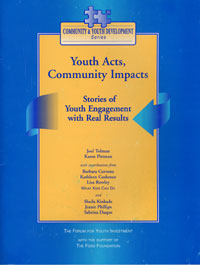
Youth Acts, Community Health Impacts: Two Examples
Expertise, training and professional standing have come to be the price of admission into community development work. As community development has become synonymous with housing and financing in particular, and the field has evolved in general, young people often find it hard to make it in the door of community development organizations. But even if community development work is defined more broadly — including the range of areas of community work — professionalization is still an often insurmountable obstacle to youth involvement. When it comes to community health issues, this is certainly the case. Young people find themselves in an unfamiliar world of medical malpractice, physician’s codes of conduct, hospital bureaucracy and genuine field expertise.
Yet young people continue to find ways to make meaningful impact on community health issues. Witness the experiences of two very different efforts — Project HEALTH and a national network of peer health educators in America — both providing vital community development functions in challenging situations.
Project HEALTH
It is hard to argue with either the individual stories or the sweep of statistics that emerge from Project HEALTH’s work in Boston, Providence and Harlem. Boston Family Help Desk — a centerpiece of Project Health — links about 1,000 families a year with the supports that physicians simply can’t offer during 15-minute hospital appointments: food, safe shelter, health insurance, job training and child care. A swimming program takes on the pervasive problem of urban childhood asthma, resulting in improvements in lung capacity that are four times what is possible via medication. And Project HEALTH volunteers provide personal supports and advice to young people dealing with a number of chronic illnesses, helping them to better manage and cope with their diseases. Connected to each of these programs — there are about two dozen in all — are quotes like this one from a Boston parent:
I have asthma, so [growing up] I used to go the emergency room a lot too. I missed a lot of school. I barely graduated because of my attendance. I didn’t want that for my kids. I really wanted them to be in school, to learn, to get a good education.
How is it possible for young people to make contributions like these? The model that makes these impacts possible goes to the heart of the “expertise” issue. College students — many with little or no health-related experience — design and implement programs that bring together existing community resources and medical infrastructure to better meet the needs of families. Critical to the success of these programs are professional mentors — doctors, lawyers, family advocates, nurses — who both identify the issues that the programs address and guide every step of the development process. The mentors bring vital knowledge of both the medical field and the community.
But the organization’s commitment to community engagement goes much further. “One thing I’m proud of is the deep partnership and collaborations we’ve developed with the community,” says Project HEALTH Executive Director Tara Purohit. “In a lot of volunteer experiences, students are in and out. That’s a frustrating experience for the volunteers — but mostly for the community members. We’re trying to overcome that. For instance, community members are involved every time we hire new staff. We have a neighborhood orientation day for all new volunteers, led by members of the community.”
The young people, for their part, provide substantial people power and a commitment to do what medical professionals can’t — bring nonmedical supports into medical settings and bring medical resources out into communities where they’re often absent. Young people end up as vital brokers between families and medical professionals, as well as linkers to the supports that make good health possible — housing, food, income. Their contributions are anything but sporadic — volunteers average 10-15 hours per week of involvement, and nearly all stay engaged through all four years of college. And the majority go on to work with low-income communities after graduation.
The lesson for other organizations: rather than attempting to take over for community development professionals, young people may have the most impact when they work side-by-side or in close consultation with these professionals.
